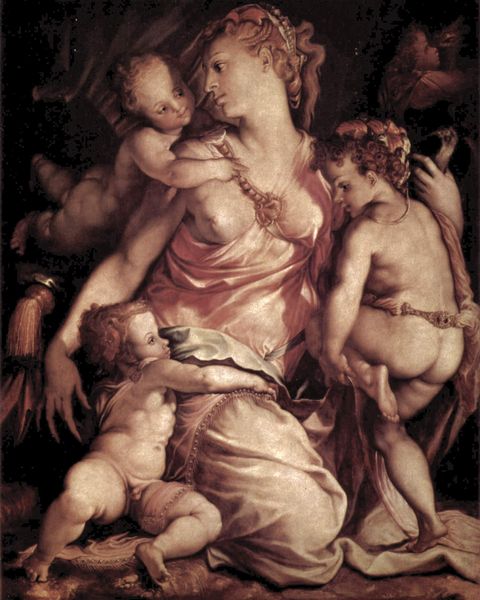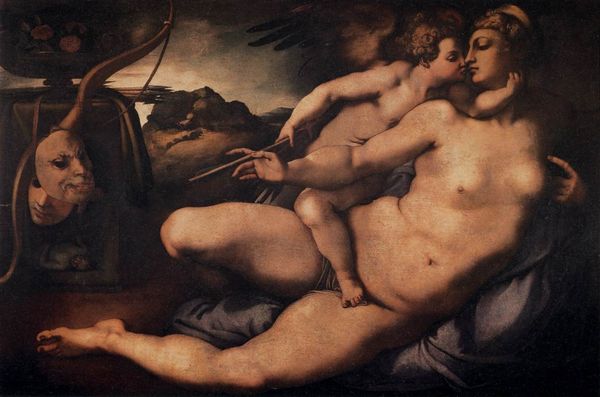
painting, oil-paint
#
high-renaissance
#
allegory
#
narrative-art
#
painting
#
oil-paint
#
classical-realism
#
figuration
#
mythology
#
human
#
history-painting
#
italian-renaissance
#
nude
Copyright: Public domain
Curator: This artwork by Il Sodoma, titled "The Death of Lucretia," dates back to 1513 and plunges us into a rather grim scene. What springs to mind when you first gaze upon it? Editor: A somber and heavy drama, rendered with such stark flesh tones against the almost engulfing darkness. It's theatrical, isn't it? Like a stage lit for a tragic finale. The very texture of the paint seems to weigh down the narrative. Curator: Indeed, that weight echoes the story it tells—Lucretia's suicide to redeem her honor after being assaulted. Sodoma masterfully uses oil paint, manipulating it to both highlight her vulnerability and the grim resolve of those around her. I almost feel I’m peering into a private, sacred moment of ultimate sacrifice. Editor: Right, oil on panel. Let’s not forget the raw materials. We see the impact of Renaissance workshops; skilled labor churning out these paintings with certain patrons in mind. Look at the almost sculpted figures – it’s like he's acknowledging both the sensuality of flesh and the violence perpetrated upon it. Curator: I think so too. And those fabrics, draping and clinging in ways that amplify her distress, almost weaving themselves into the unfolding narrative. Can you imagine how those hands framing Lucretia embody the weight and responsibility they now shoulder? There's almost a discomfort I feel in those heavy shrouds, which reminds us of morality. Editor: Morality certainly. But also power and its uneven distribution. Think about who gets to control narratives of female virtue and violation, then and now. Also how much the patron’s purse could sway subject matter and presentation, shaping narratives to serve social agendas. The oil pigment came from somewhere, the brush from a craftsman—all part of the grand production. Curator: It's like that moment is trapped for all of time within those pigments and brushstrokes. Though stark and difficult, the painting does feel charged with an energy and presence. Editor: Absolutely. A somber commentary painted onto its wooden base by layers of oil. Let’s think on how these objects of art can reveal histories often scrubbed clean by more traditional historical narratives. A look at labor as well. Curator: I suppose we could leave reflecting how complex even what seems to be only an artist’s subjective interpretation can be, as they’re all molded through social, economic, and historic events. Editor: I think we may be onto something then, this painting isn't just about one tragic ending, but an encapsulation of the system in motion that crafted it.
Comments
No comments
Be the first to comment and join the conversation on the ultimate creative platform.













